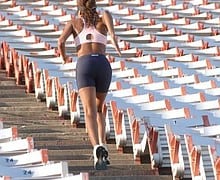Running, cycling, kickboxing? Get the right shoe for the activity
Have you ever felt aching knees or back pain during or after running or an aerobic workout? In step class do you find that your knees are feeling under pressure? It very well could be that your sneakers (ahem, now called fitness shoes) are causing the pain. Used sneakers might still look nice, but they may have lost their support and ability to absorb shock. According to a Mayo Clinic report, sneakers should be changed after 150 hours of cross training. If you work out three days a week and remove your sneakers after each workout (not using them for everyday running around), your sneakers should last about one year. I teach at least six classes a week, so I replace my sneakers every 4 to 6 months. Runners should replace their sneakers every to 300 to 500 miles, and walkers every 1,000 miles.
There are various types of fitness shoes for different activities, and I am not convinced all activities need their own shoe. The most basic types are running shoes and aerobic shoes. Running shoes are designed to absorb the impact of forward motion, while aerobic shoes are designed to cushion jumps and lateral moves. Note that these activities use the feet in different ways, so a running shoe can lead to knee pain, shin splints, arch pain and back problems if used in an aerobics class, and aerobic shoes can lead to similar problems if used for running. It really is important to use the proper shoe for the right activity. Cross-trainer fitness shoes are designed with the forefoot flexibility needed for running, but also have the lateral support you’d want for aerobics and tennis. However, if you consistently run or take aerobics, purchase shoes specifically made for either running or aerobics.
There are shoes for spinning (stationary cycling classes), kickbox and Zumba. Since there is no jumping or running in spin classes, I am not convinced of the need for special shoes. And for kickbox classes, good cross trainers or aerobics sneakers will fit the bill. Because I teach many Zumba classes, I find that dance sneakers, which can be found at most dance stores and websites, relieve knee pressure from doing many, many salsa, merengue and samba steps. If you are doing one or two classes a week, purchasing dance sneakers may not be warranted. However if you find that your knees bother you after a Zumba class, consider investing in dance sneakers.
Never purchase shoes based on size. Manufacturers have different lasts and moldings, which vary in arch height, heel width and toe box size, so certain manufacturers’ shoes will fit you better than others. A size 8 Reebok may translate into a size 8-1/2 Nike. It all depends on the cut and shape of the sneaker. Ensure that there is room to wiggle your toes with your workout socks on (which should also provide some shock absorbency). The shoe should also provide good heel support, meaning your heel should not be able to move while doing activities. Women, if your feet are very wide, try on boy’s or men’s sneakers, which tend to have wider boxes. Fitness activities swell the foot, so try to purchase fitness shoes at the end of the day when feet are biggest.
If problems persist after the purchase of sneakers, see a podiatrist to determine possible pronation issues that need to be addressed in assessing sneaker fit and comfort. More than half of all people overpronate, which tends to be associated with a low or flat arch, or underpronate, which is associated with a high arch.
Proper sneaker fit is a simple fix that can keep pain and injury from being a deterrent in your goal to stay fit.
Fitness guru Benita Perkins can be contacted with questions at benita@benniegirl.com.





